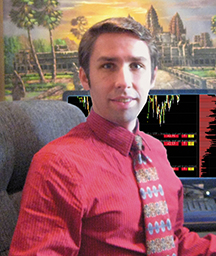INTERVIEW
Afraid To Trade?
Conquering Your Trading Fears With Corey Rosenbloom

Corey Rosenbloom, Cmt, is the founder of www.afraidtotrade.com, a website dedicated to helping traders overcome their trading fears through education, and is the author of The Complete Trading Course (John Wiley & Sons, 2011), which outlines how to combine foundational principles, analysis techniques, and trade setups into a broader perspective. He began investing using fundamental analysis in 1998 during the runup to the market top in 2000, and the ensuing bear market opened his awareness to the field of technical analysis as a way to enhance performance and manage risk more effectively. Having also incorporated sector rotation and intermarket analysis into his investment and trading strategy, Rosenbloom switched to shorter time frame trading tactics to capture additional edge from the price action and trends. He began writing the afraidtotrade.com blog to share some of his experiences and define strategies, which detail his unique style of incorporating both the larger perspective of intermarket analysis with the shorter, intraday trading strategies that can be employed to minimize risk.
Stocks & Commodities Editor Jayanthi Gopalakrishnan and Staff Bruce R. Faber interviewed Rosenbloom via telephone on April 4, 2011.
Corey, tell us how you got interested in trading.
I credit my father, who is an investor, and who was constantly prodding me to study business. We would talk stocks each evening, though what really got me into it more than just for fun was a stock market challenge in my high school. That got competitive and the entire class participated, and our team placed quite well, with most of us taking the challenge very seriously. That got me motivated. Dad helped in terms of looking at stocks and he focused on investment style, similar to that of Warren Buffett. He would read company prospectuses and focus on the fundamentals of the company.
That was before I discovered and started to practice charting. Of course, the market went up in 1998, 1999, and 2000. We did not get involved in the tech market bubble. We stayed away from the stocks we did not understand. If we could not talk about it, or understand it, or read the fundamentals of it — and a lot of those companies did not have fundamentals at that time — we just did not take part.
Traders who are unbiased and not scared to take advantage of the unexpected are in the best position.
It was good to have that runup and the early success in the first few years. While I was in college, the stock market crashed. We lost money, but not to the extent that many others did. We had friends here in Huntsville, AL, who got involved in the tech bubble and they lost almost everything, because they got involved in that mania. They made a lot of money quickly, but they lost it just as quickly. We were able to sidestep that. My dad instilled in me that I shouldn’t just enter a trade because I thought it was interesting or hyped-up, or the price was low. It is all about price, fundamentals, and values. So do what works and stay away from what doesn’t. Sure, we lost money in that period, but we had early success, and that got me hooked.
When did you get interested in charting?
In college. I got involved in technical analysis through visiting StockCharts.com, reading books by John Murphy and Martin Pring. I got involved in a hybrid strategy where you select companies with good fundamentals but use the charts too. If the stock is a good fundamental buy but the stock is trending down, maybe it is not a good time to go long that stock.